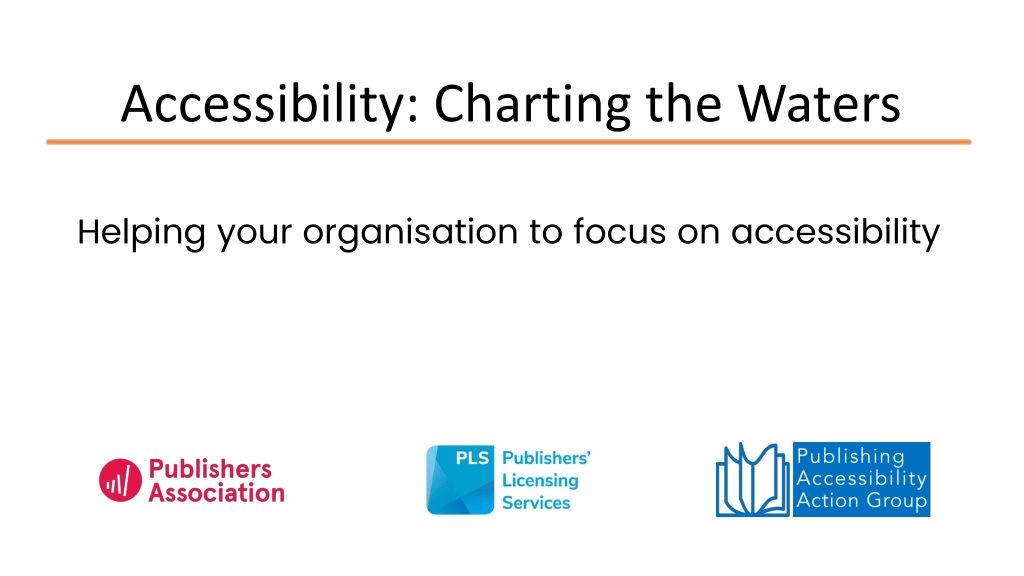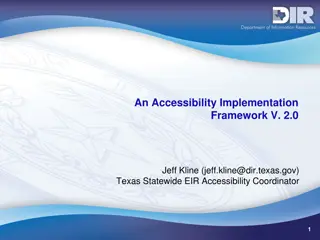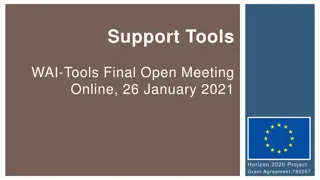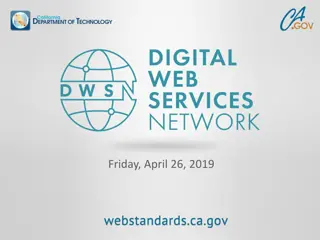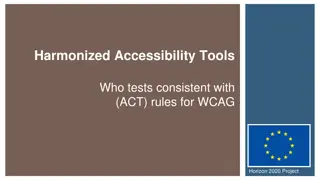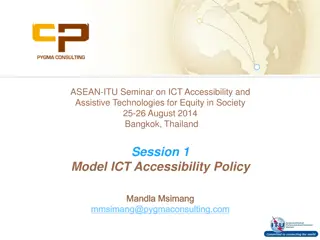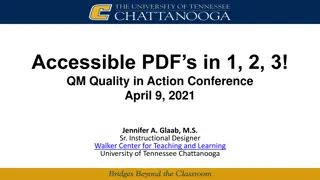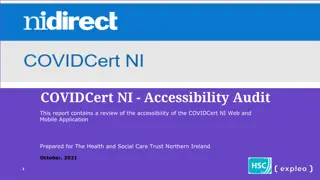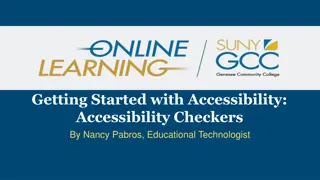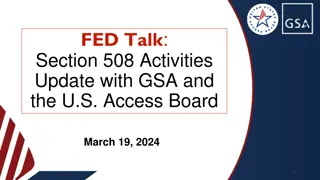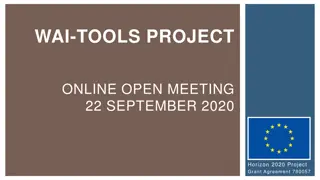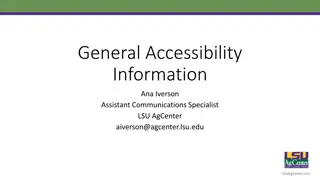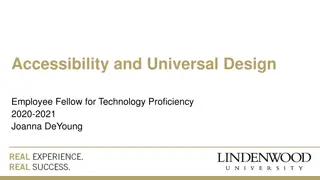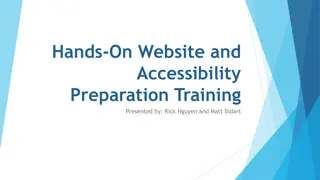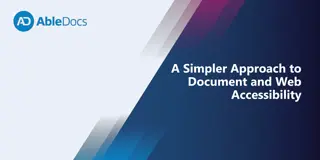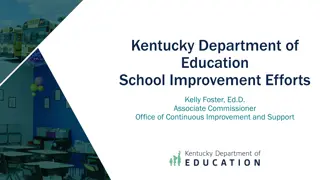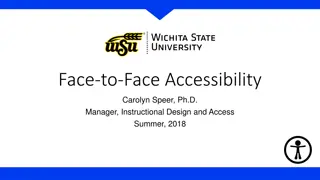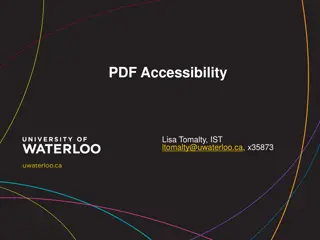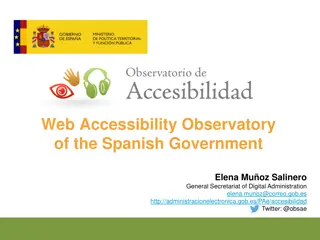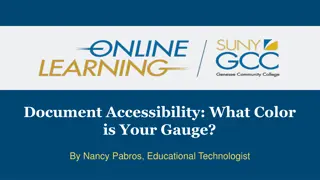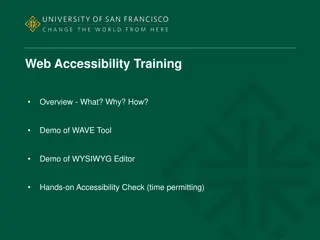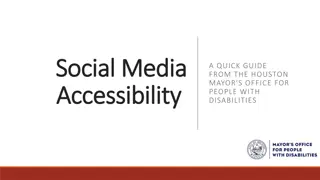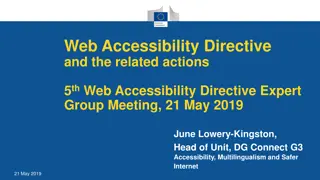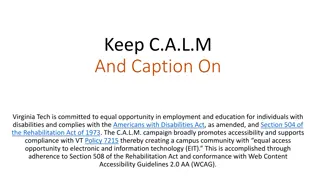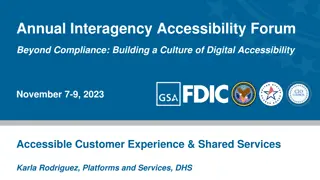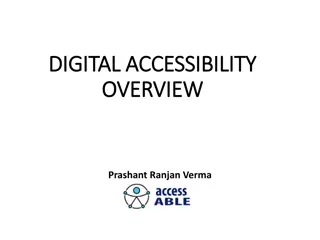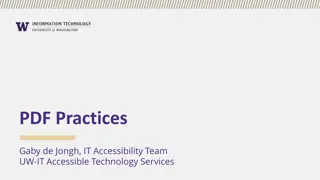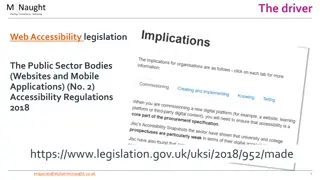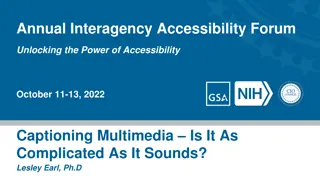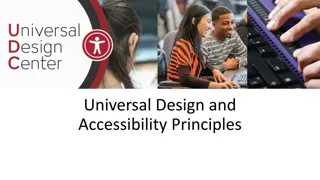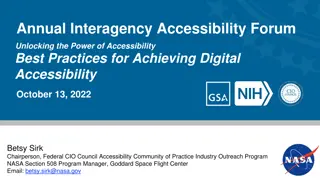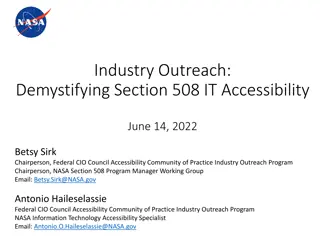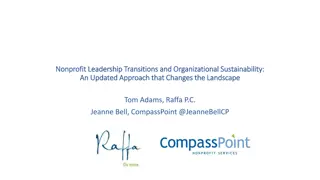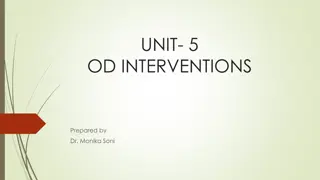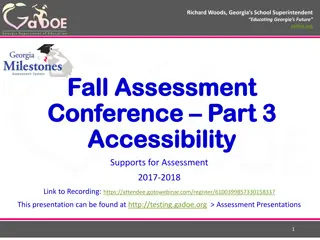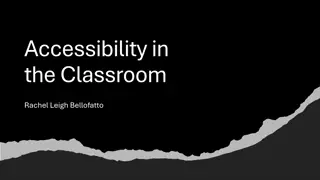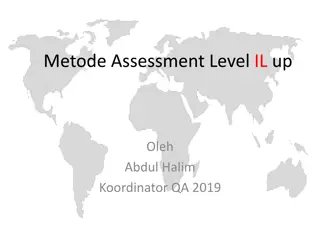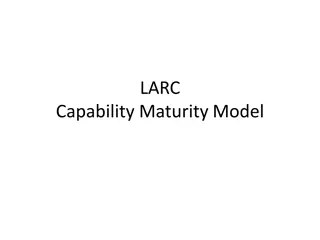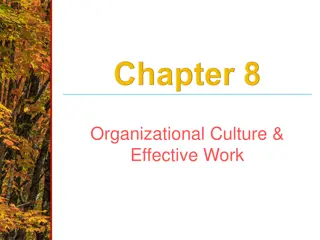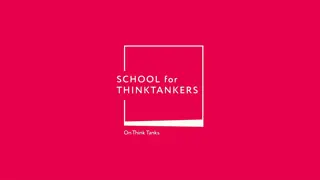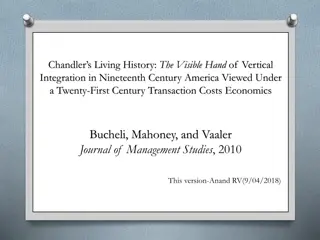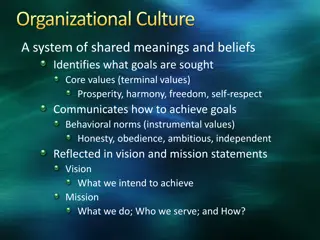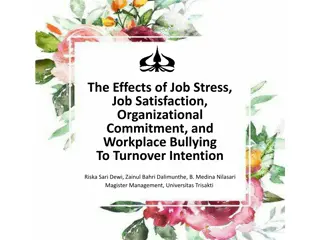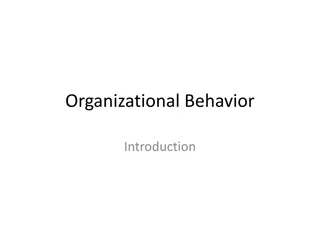Enhancing Accessibility: A Comprehensive Approach for Organizational Improvement
Empower your organization to prioritize accessibility by committing to the PAAG Charter's guidelines, including raising awareness, training staff, designating an accessibility champion, and advocating for accessibility standards. Learn from industry experts Richard Orme and Simon Mellins on implementing these initiatives effectively. Explore strategies for testing content usability, partnering with key organizations, and monitoring progress to ensure inclusivity in digital publications and platforms.
Uploaded on Oct 04, 2024 | 0 Views
Download Presentation

Please find below an Image/Link to download the presentation.
The content on the website is provided AS IS for your information and personal use only. It may not be sold, licensed, or shared on other websites without obtaining consent from the author. Download presentation by click this link. If you encounter any issues during the download, it is possible that the publisher has removed the file from their server.
E N D
Presentation Transcript
Accessibility: Charting the Waters Helping your organisation to focus on accessibility
The PAAG Charter asks you to commit to: (1) raising awareness among, and providing training for, relevant staff. nominating a company accessibility champion who can bring together key stakeholders to discuss potential accessibility improvements and act as a liaison for all accessibility information publishing our accessibility policy on our website, including our commitment to this Charter. designating and publicising a point of contact in our organisation to assist persons with disabilities to access alternate formats of our content. incorporating appropriate accessibility features within our digital publications and platforms, according to the Web Content Accessibility Guidelines and other appropriate accessibility standards.
The PAAG Charter asks you to commit to: (2) advocating for accessibility standards and collaboration throughout the publishing supply chain from author to reader. utilising the accessibility metadata opportunities available to aid with the discovery of accessible content. testing and validating content to ensure it is usable by people with print disabilities. Ideally this would include testing by persons with lived experience. partnering with national and international organisations that provide support for the availability of publications in accessible formats. monitoring our progress in this area and regularly assessing the accessibility of our digital publications and platforms.
Richard Orme, DAISY Consortium raising awareness among, and providing training for, relevant staff nominating a company accessibility champion who can bring together key stakeholders to discuss potential accessibility improvements and act as a liaison for all accessibility information
Simon Mellins, Penguin Random-House publishing our accessibility policy on our website, including our commitment to this Charter designating and publicising a point of contact in our organisation to assist persons with disabilities to access alternate formats of our content
Getting the Word(s) Out: How to Shout About Your Accessibility Work Simon Mellins | Ebook Technical Coordinator | Penguin Random House UK
So youve signed the PAAG Charter Congratulations! Your organisation is helping to make things better. All the great accessibility work you re doing is far less useful if nobody knows it s there You also (deservedly) may want to boast about it! Help users make the best of what you ve done and broaden your audience Making it known is also part of your commitment when signing the Charter
PAAG Charter Clause 3 Publishing our accessibility policy on our website, including our commitment to this Charter.
Accessibility Policy on your website - Why? Part of the point of signing the PAAG Charter is to make an outward- facing commitment to advancing accessibility however your organisation can - this is something to shout about! Show everyone that you are a committed, conscientious and inclusive organisation Help readers easily and quickly find out your policies and how to get help Also a requirement of EAA Allows you to link to the Charter to show the detail of your commitment instead of having to retype it all yourself Helps bring more attention to the Charter
Accessibility Policy on your website - How? The PAAG website contains resources for creating your accessibility statement Look at lots of websites accessibility statements to get ideas Remember you need to cover your books, not just your website! As for the charter, it s as easy as adding something like: [Organisation name] is a proud signatory of the UK Publishing Accessibility Action Group's Charter for Accessible Publishing You can also display the PAAG Accessible Publishing Charter logo Statement also needs to give contact information
PAAG Charter Clause 4 Designating and publicising a point of contact in our organisation to assist persons with disabilities to access alternate formats of our content.
Point of Contact - Why? Important for requests to not just get ignored or lost in endless forwarding chains Organisations need planned response workflows for these requests Having an individual/small team take direct ownership of this helps ensure you re as helpful and reliable as possible to those who need your help Legal requirement in some areas/jurisdictions The technology and legislation around accessibility changes over time, so organisations will need a plan for staying up-to-date
Point of Contact - How? Give contact email address or other suitable contact method in accessibility statement Point of contact doesn t have to be one person, can be a shared mailbox as long as it s regularly monitored and at least one person has direct responsibility for checking it regularly Doesn t necessarily mean one person/team who is going to resolve the request directly. Can just be person/team who knows who to contact within your organisation, or can signpost the reader to a relevant external organisation or service Can also provide these details via ONIX
Conclusion: Spread the Word(s)! The PAAG Charter is created and maintained by volunteers, and we need your help to spread the word and help make signing the PAAG charter, and living up to its values, an essential part of being a responsible member of the UK publishing industry. As well as signing the charter (as a publisher or an ally), you can help by sharing our LinkedIn posts and website guidance, and even get involved with PAAG directly. Help us in our efforts to accelerate our industry s journey toward making accessibility a part of business-as-usual.
Laura Brady, EBound incorporating appropriate accessibility features within our digital publications and platforms, according to the Web Content Accessibility Guidelines and other appropriate accessibility standards advocating for accessibility standards and collaboration throughout the publishing supply chain from author to reader
Martin Klopstock, Kogan Page utilising the accessibility metadata opportunities available to aid with the discovery of accessible content testing and validating content to ensure it is usable by people with print disabilities. Ideally this would include testing by persons with lived experience
Utilising the accessibility metadata opportunities available to aid with the discovery of accessible content 1. Ensure consistent metadata across the supply chain and in the assets themselves. 2. Accessibility metadata in ONIX messages and EPUBs is full, accurate, aligned + includes GCA accreditation badge 3. Check that this metadata is accurately surfaced on e-reader/vendor platforms. 4. Make your accessible EPUBs available in a dedicated ebook store (Benetech/Vitalsource) 5. Craft a meaningful Accessibility Statement and have it ASPIRE rated
Consistent metadata EPUB OPF <meta property="schema:accessibilitySummary">A complex book with images, tables, list items and complex formatting, which are defined with accessible structural markup. This book contains various accessibility features such as alternative text and long descriptions for images, table of contents, page-list, landmarks, reading order, index and semantic structure. Where applicable, there are backlinks from in-text headings back to the Table of Contents, and from in-text figures and tables back to the List of Figures and List of Tables.</meta> ONIX <ProductFormFeatureDescription>A complex book with images, tables, list items and complex formatting, which are defined with accessible structural markup. This book contains various accessibility features such as alternative text and long descriptions for images, table of contents, page-list, landmarks, reading order, index and semantic structure. Where applicable, there are backlinks from in-text headings back to the Table of Contents, and from in-text figures and tables back to the List of Figures and List of Tables.</ProductFormFeatureDescription>
Vitalsource a11y metadata for a Kogan Page title
Website Accessibility Statement https://www.koganpage.com/page/accessibility
Testing and validating content to ensure it is usable by people with print disabilities. Ideally this would include testing by persons with lived experience 1.Consider GCA accreditation and annual re-accreditation 2.Consider developing an XHTML Schema in line with GCA requirements 3.Create an online validator that checks every ebook against DAISY Ace, EPUBCheck and our own XHTML specification (& ensures each book meets GCA requirements) 4.Running any larger developments past industry experts 5.Regularly check various e-reader/vendor platforms
USEFUL RESOURCES ONIX LIST 196 Kogan Page Accessibility Statement Benetech Accessible Ebook Store ASPIRE by TextBox Digital
Richard Orme, DAISY Consortium partnering with national and international organisations that provide support for the availability of publications in accessible formats monitoring our progress in this area and regularly assessing the accessibility of our digital publications and platforms
What next? Visit paag.uk for resources, business case, and more Join PAAG via LinkedIn Sign the PAAG Charter for Accessible Publishing See you at PAAG meetings!
